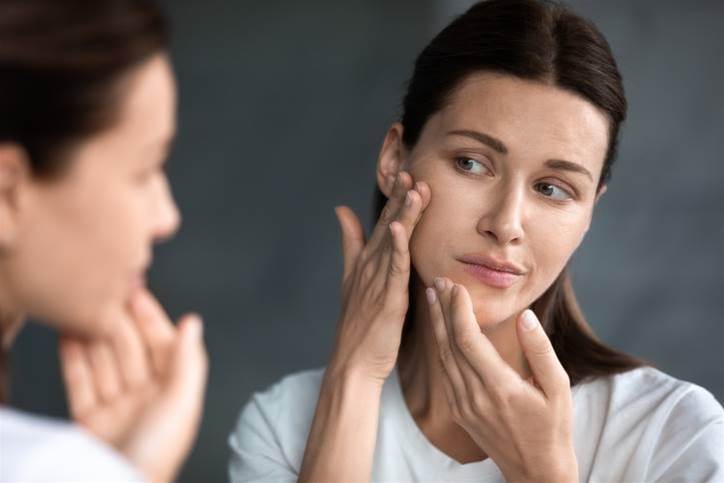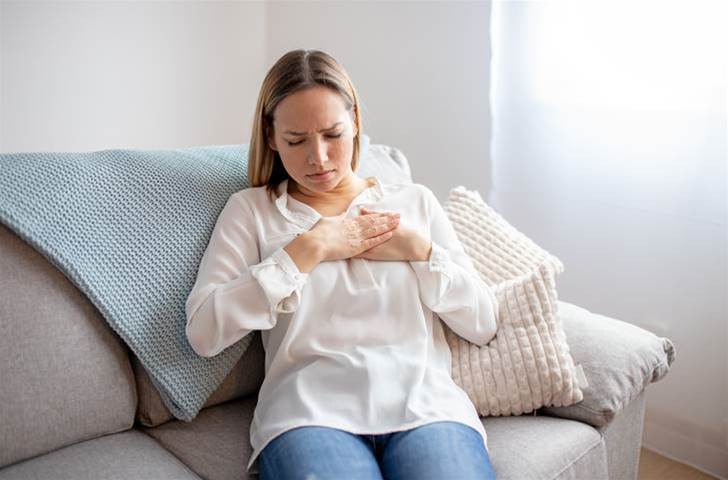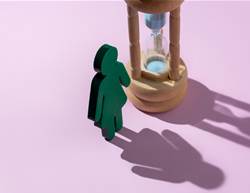When you think of menopause, which side effects come to mind? Hot flushes? Erratic periods. A muffin top that just won’t shift? Though these classic hormonal blahs commonly affect women during midlife, a host of lesser-known symptoms may also kick in, taking many women by surprise. The good news is that once you and your doctor realise your hormones are to blame there are some simple strategies to help you return to your old self.
IS IT PERIMENOPAUSE?
Most women enter perimenopause in their early 40s, but it can start in the 30s.“Though on average perimenopause lasts around four to six years for most women, it can be as short as a year or last for more than 10 years,” says Dr Elizabeth Farrell from Jean Hailes for Women’s Health in Melbourne. Signs of this hormonal shift, such as irregular periods and mood swings, may come in waves, increasing and receding for days or months at a time. You will know you have hit menopause if you’ve had no period for 12 months.
SAFETY OF HORMONE REPLACEMENT THERAPY
A link between breast cancer and hormone replacement therapy (HRT) reported back in 2002 caused a sharp decline in women’s willingness to use hormonal therapy to treat their menopause symptoms. “In fact these statements were incorrect and misreported findings,” explains Farrell. “The global consensus among expert medical societies now is that HRT (now also called menopausal hormone therapy) is low risk in healthy women aged 50-60. Millions of women around the world still avoid HRT in the mistaken belief it is unsafe. This is very unfortunate as using HRT can help to reduce risk of osteoporosis and cardiovascular disease in women undergoing hormonal changes of perimenopause and menopause.”
SKIN CHANGES

When oestrogen levels dip during menopause, women may experience seemingly inexplicable changes in their skin. It turns out that oestrogen supports many of the normal skin functions, from skin cell turnover to blood supply, the plumpness or fat volume in our skin and, yes, hair distribution (hello chin wisps!). As a result, when oestrogen levels dip, the following may occur:
Dryness and sensitivity: This may include greater facial flushing, redness and rosacea, along with easy bruising on the body. Changes to facial hair: Some women notice an increase in facial hair or coarsening of hair that used to be finer and less obvious.
Prickly skin: “Menopausal hormone changes can cause some women to experience ‘formication’ – a sensation that can feel a little like ants crawling under the skin,” explains Dr Elizabeth Farrell, gynaecologist and medical director of Jean Hailes for Women’s Health in Melbourne.
WAYS TO FIND RELIEF
Keep up moisture levels: Long hot showers may strip your skin of natural oils, leaving it more dehydrated and prone to itching so keep that morning cleanse short but sweet. Also apply moisturiser when skin is wet, which will help trap in additional moisture under your body lotion or face cream. Reapply it several times a day if your skin is now extremely dry or feels tight. Choose hypoallergenic creams as they don’t contain perfumes, preservatives or other chemicals that may inflame your skin.
New ingredients to add to your diet: Some foods can actually mimic the effects of oestrogen. “Good sources include soy foods, legumes (such as chickpeas and lentils), sprouts, flaxseeds, oats, rice, barley and quinoa,” suggests Jean Hailes naturopath, Sandra Villella.
Top up your supply of sunscreen: “Protecting your skin from UV damage helps prevent further dehydration or inflammation,” says Dr Adam Sheridan, dermatologist and director of Specialist Dermatology, Surgery & Laser clinics in Adelaide and Melbourne. Don’t forget to apply broad-spectrum sunscreen 20 minutes before going outdoors. Also wear a wide-brimmed hat.
Take a big picture approach: “I recommend women take a ‘ holistic’ approach, which may involve supportive and reparative skincare, nutritional supplements and prescribed topical creams. Physical therapies such as laser and injectables can also address flushing, vascular rosacea, unwanted hair and thinning of the skin,” Sheridan explains.
HEART PALPITATIONS

As women approach menopause they may sometimes experience sudden and rapid fluttering or pounding sensations in their chest or they may feel as though their heartbeat has suddenly sped up. “These palpitations can be associated with hormonal fluctuations and are often triggered by hot flushes,” explains Professor Garry Jennings, the Heart Foundation’s chief medical advisor. “Mostly they are uncomfortable though harmless, but women should still seek advice to rule out other causes, including overactive thyroid, or heart arrhythmias.” Caffeine, stress, anxiety, excessive exercise, and some medications can also trigger heart palpitations.
ANXIETY
Hormonal fluctuation during this stage of your life can lead to constant butterflies, increased social anxiety or feeling intensely wound up or wired most of the time. In fact, frequent nervousness affects an estimated 51 per cent of women aged 40-55, during perimenopause, US research shows.
“Many women who have never experienced anxiety before may suddenly find themselves grappling with mild, moderate or severe anxiety at midlife, without realising their wildly shifting hormones are responsible,” says Dr Caroline Thew, Endocrinologist. “This anxiety may then increase the risk of also developing depression.” These symptoms come along at a time when many women are already pushed to their limits by juggling work and family, caring for parents or undergoing big changes such as divorce or empty nest. This can all create a double-whammy, as feeling stressed can feed hormonal anxiety.
“These life stressors can cause the release of stress chemicals such as cortisol and adrenaline, which increase the sensitivity of a woman’s hormone receptors so that she has an even bigger reaction to the midlife hormonal swings from high to low oestrogen,” Thew explains. Whew! Nice to know that it’s not really you – it’s chemical.
Some research also suggests that certain types of hormone replacement therapy may exacerbate anxiety further in some women. “So if you find your anxiety increases on HRT, you may need to trial a different mix of hormones,” Thew suggests.
WAYS TO FIND RELIEF
Recognise triggers: Make a diary note of any factors such as caffeine or late nights that ramp up your anxiety, even if they never used to make you anxious. Recognising patterns will allow you to minimise triggers. Visit anxiety.jeanhailes.org.au to better understand what anxiety is.
Practise mindfulness: When you use all your senses to focus on what you are doing right now you are less likely to engage in anxious thoughts.
Hormone replacement therapy: A form of HRT called Tibolone can help reduce symptoms of anxiety and depression, according to research conducted at Monash University in Melbourne.
Antidepressants: “Antidepressants with a shorter half-life – which means they stay in the body for a shorter period of time – tend to be less agitating and more calming, while antidepressants that last longer in the body can make menopausal anxiety worse in some women,” Thew says. Finding the right one for you may be a process of trial-and-error with your doctor.
DEPRESSION

Oestrogen appears to have a protective effect against a low mood. A growing body of research suggests that when it drops in the lead-up to menopause and beyond, that plummet may also lower levels of serotonin – known as the happiness hormone – and dopamine, also called the pleasure hormone.
“This may partly explain why women who have never suffered from depression before are two to four times more likely to experience depression at perimenopause,” Thew says.“This hormonally linked depression may be mild and cause general feelings of sadness or it may
be crushing, leaving women feeling hopeless or despairing.”
As hormone levels in a woman’s brain can start to shift (even before obvious signs such as hot flushes or erratic periods commence) some GPs may not make the connection between menopausal changes and feelings of depression.
“In our clinic we see many women who have tried everything from antidepressants and cognitive behavioural therapy to mindfulness and meditation and their depression is just not lifting, because the hormonal changes driving the depression are not being addressed,” Thew explains.
“As a general rule, higher levels of oestrogen cause an increase in mood so when they rise then fall during midlife, women may experience mood swings. Progesterone levels start to also lower, so a sudden spike may then cause irritation and grumpiness in some women.”
BLADDER BOTHERS
Oestrogen also helps to keep the tissue in your bladder and pelvic floor stronger and more flexible, so when oestrogen levels drop during midlife, the tissues of the vagina and urethra can lose elasticity.
“These hormone shifts can lead to changes in the lower urinary tract that can cause greater frequency and urgency to urinate,” Farrell explains.
You may find that you wake more often at night with the need to urinate. “It can also lead to ‘urge incontinence’, which causes women to leak urine,” she says.
But there’s no need to be embarrassed – there are solutions, some as simple as adding linseed to your cereal or salads. “Research suggests that taken in a quantity of 25g (two tablespoons) a day they can reduce vaginal dryness in postmenopausal women by ‘plumping up’ vaginal cells,”
says naturopath, Sandra Villella.
Doing simple pelvic floor exercises can help strengthen your muscles and give you back control. Start by squeezing your pelvic floor for 5-10 seconds with a break of 10 seconds between. Repeat 10 times. That daily commute to and from work is a good time to do it – no-one will even know!
LESS INTENSE ORGASMS
Getting closer to menopause, some women find that it takes longer to reach orgasm or their sexual climax may feel shorter or less intense. They may no longer experience a wave of contractions at climax (or climax contractions may feel weaker), or they might keep coming to the cusp of orgasm but find they can’t reach the peak of climax.
“There is a misconception that this change in orgasm occurs due to a drop in testosterone,” Farrell says. “In fact, this is not the case because testosterone gradually falls over the years and does not decline sharply during perimenopause and menopause.” Instead, Farrell says the most likely cause is that the reduction in oestrogen leads to reduced blood flow to the pelvic area.
“There can also be changes in nerve activity in the clitoris, changes in the tone of the skin in the vagina and the pelvic floor, and less lubrication during sexual arousal,” Farrell points out. “All of these factors combined can reduce a woman’s arousal level and may contribute to a lower intensity of orgasm.” It’s important to note some health conditions, such as high blood pressure and diabetes, can also impact on your enjoyment of sex so don’t hesitate to talk with your doctor.
WAYS TO FIND RELIEF
Strengthen your pelvic floor: “A strong and toned pelvic floor can make your orgasms more pleasurable and intense,” Farrell says.
Take time for intimacy: Snuggle up on the couch, take a bath together, and give each other a foot massage. Relaxing together and being physically close can help revive your libido and boost intimacy, which can help a woman feel more relaxed and in turn increase desire.
Focus on foreplay: Instead of treating it as a sexual appetiser, savour it like a main course. “Lengthy touching, kissing and stroking can make a big difference to a woman’s arousal, relaxation, lubrication and pleasure during sex,” Farrell says.
Apply creams for comfort: Lubrication applied to your vulva, can help make sex more pleasurable and less painful. Choose one free of perfumes and preservatives if you tend to have sensitive skin.
Apply topical oestrogen: “Ask your GP for a script for oestrogen cream,” Farrell suggests. “Applying an oestrogen cream topically in the vagina twice a week can greatly improve a woman’s level of comfort during sex, which in turn may enhance her arousal and orgasm.”
For more articles by Prevention on health, beauty and wellbeing, sign up to our weekly newsletter.








.png&h=193&w=250&c=1&s=1)
.jpg&h=193&w=250&c=1&s=1)
